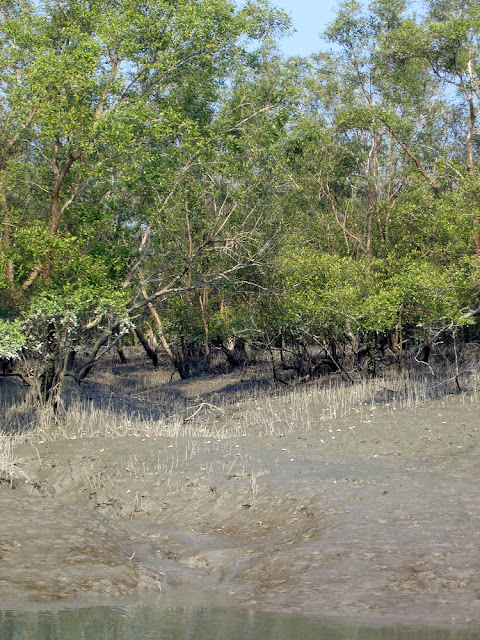The Sundarbans
The Sundarbans mangrove forest, one of the largest such forests in the world (140,000 ha), lies on the delta of the Ganges,Brahmaputra and Meghna rivers on the Bay of Bengal. It is adjacent to the border of India’s Sundarbans World Heritage site inscribed in 1987. The site is intersected by a complex network of tidal waterways, mudflats and small islands of salt-tolerant mangrove forests, and presents an excellent example of ongoing ecological processes. The area is known for its wide range of fauna, including 260 bird species, the Bengal tiger and other threatened species such as the estuarine crocodile and the Indian python.
Outstanding Universal Value
Brief synthesisThe Sundarbans Reserve Forest (SRF), located in the south-west of Bangladesh between the river Baleswar in the East and the Harinbanga in the West, adjoining to the Bay of Bengal, is the largest contiguous mangrove forest in the world. Lying between latitude 21° 27′ 30″ and 22° 30′ 00″ North and longitude 89° 02′ 00″ and 90° 00′ 00″ East and with a total area of 10,000 km2, 60% of the property lies in Bangladesh and the rest in India. The land area, including exposed sandbars, occupies 414,259 ha (70%) with water bodies covering 187,413 ha (30%).
The three wildlife sanctuaries in the south cover an area of 139,700 ha and are considered core breeding areas for a number of endangered species. Situated in a unique bioclimatic zone within a typical geographical situation in the coastal region of the Bay of Bengal, it is a landmark of ancient heritage of mythological and historical events. Bestowed with magnificent scenic beauty and natural resources, it is internationally recognized for its high biodiversity of mangrove flora and fauna both on land and water.
The immense tidal mangrove forests of Bangladeshs’ Sundarbans Forest Reserve, is in reality a mosaic of islands of different shapes and sizes, perennially washed by brackish water shrilling in and around the endless and mind-boggling labyrinths of water channels. The site supports exceptional biodiversity in its terrestrial, aquatic and marine habitats; ranging from micro to macro flora and fauna. The Sundarbans is of universal importance for globally endangered species including the Royal Bengal Tiger, Ganges and Irawadi dolphins, estuarine crocodiles and the critically endangered endemic river terrapin (Batagur baska). It is the only mangrove habitat in the world for Panthera tigris tigris species.
Criterion (ix): The Sundarbans provides a significant example of on-going ecological processes as it represents the process of delta formation and the subsequent colonization of the newly formed deltaic islands and associated mangrove communities. These processes include monsoon rains, flooding, delta formation, tidal influence and plant colonization. As part of the world’s largest delta, formed from sediments deposited by three great rivers; the Ganges, Brahmaputra and Meghna, and covering the Bengal Basin, the land has been moulded by tidal action, resulting in a distinctive physiology.Criterion (x): One of the largest remaining areas of mangroves in the world, the Sundarbans supports an exceptional level of biodiversity in both the terrestrial and marine environments, including significant populations of globally endangered cat species, such as the Royal Bengal Tiger. Population censuses of Royal Bengal Tigers estimate a population of between 400 to 450 individuals, a higher density than any other population of tigers in the world.The property is the only remaining habitat in the lower Bengal Basin for a wide variety of faunal species. Its exceptional biodiversity is expressed in a wide range of flora; 334 plant species belonging to 245 genera and 75 families, 165 algae and 13 orchid species. It is also rich in fauna with 693 species of wildlife which includes; 49 mammals, 59 reptiles, 8 amphibians, 210 white fishes, 24 shrimps, 14 crabs and 43 mollusks species. The varied and colourful bird-life found along the waterways of the property is one of its greatest attractions, including 315 species of waterfowl, raptors and forest birds including nine species of kingfisher and the magnificent white-bellied sea eagle.
Integrity
The Sundarbans is the biggest delta, back water and tidal phenomenon of the region and thus provides diverse habitats for several hundreds of aquatic, terrestrial and amphibian species. The property is of sufficient size to adequately represent its considerably high floral and faunal diversity with all key values included within the boundaries. The site includes the entire landscape of mangrove habitats with an adequate surrounding area of aquatic (both marine and freshwater) and terrestrial habitats, and thus all the areas essential for the long term conservation of the Sundarbans and its rich and distinct biodiversity
The World Heritage property is comprised of three wildlife sanctuaries which form the core breeding area of a number of species of endangered wildlife. Areas of unique natural beauty, ethno botanical interest, special marine faunal interest, rivers, creeks, islands, swamps, estuaries, mud flats, and tidal flats are also included in the property. The boundaries of the property protect all major mangrove vegetation types, areas of high floral and faunal values and important bird areas. The integrity of the property is further enhanced by terrestrial and aquatic buffer zones that surround, but are not part of the inscribed property.
Natural calamities such as cyclones, have always posed threats on the values of the property and along with saline water intrusion and siltation, remain potential threats to the attributes. Cyclones and tidal waves cause some damage to the forest along the sea-land interface and have previoulsy caused occasional considerable mortality among some species of fauna such as the spotted deer. Over exploitation of both timber resources and fauna, illegal hanting and trapping, and agricultural encroachment also pose serious threats to the values of the property and its overall integrity.
Protection and management re
The property is composed of three wildlife sanctuaries and has a histentsory of effective national legal protection for its land, forest and aquatic environment since the early 19th century. All three wildlife sanctuaries were established in 1977 under the Bangladesh Wildlife (Preservation) (Amendment) Act, 1974, having first been gazetted as forest reserves in 1878. Along with the Forest Act, 1927, the Bangladesh Wildlife (Preservation) (Amendment) Act 1974, control activities such as entry, movement, fishing, hunting and extraction of forest produces. A number of field stations established within Sundarbans West assist in providing facilities for management staff. There are no recognised local rights within the reserved forest with entry and collection of forest products subject to permits issued by the Forest Department.The property is currently well managed and regularly monitored by established management norms, regular staff and individual administrative units. The key objective of management is to manage the property to retain the biodiversity, aesthetic values and integrity. A delicate balance is needed to maintain and facilitate the ecological process of the property on a sustainable basis. Another key management priority is the maintenance of ongoing ecological and hydrological process which could otherwise be threatened by ongoing developmental activities outside the property. Subject to a series of successively more comprehensive management plans since its declaration as reserved forest, a focus point of many of these plans is the management of tigers, together with other widlife, as an integral part of forest management that ensures the sustainable harvesting of forest products while maintaining the coastal zone in a way that meets the needs of the local human population. The working plans for the Sundarbans demonstrate a progressive increase in the understanding of the management requirements and the complexity of prescriptions made to meet them.Considerable research has been conducted on the Sundarbans wildlife and ecosystem. International input and assistance from WWF and the National Zoological Park, the Smithsonian Institution as well as other organisations has assisted with the development of working plans for the property, focusing on conservation and management of wildlife.The Sundarbans provides sustainable livelihoods for millions of people in the vicinity of the site and acts as a shelter belt to protect the people from storms, cyclones, tidal surges, sea water seepage and intrusion. The area provides livelihood in certain seasons for large numbers of people living in small villages surrounding the property, working variously as wood-cutters, fisherman, honey gatherers, leaves and grass gatherered.
Tourism numbers remain relatively low due to the difficult access, arranging transport and a lack of facilities including suitable accommodation. Mass tourism and its impacts are unlikely to affect the values of the property. While the legal protection afforded the property prohibit a number of activities within the boundaries illegal hunting, timber extraction and agricultural encroachment pose potential threats to the values of the property. Storms, cyclones and tidal surges up to 7.5 m high, while features of the areas, also pose a potential threat with possible increased frequency as a result of climate change.




No comments:
Post a Comment